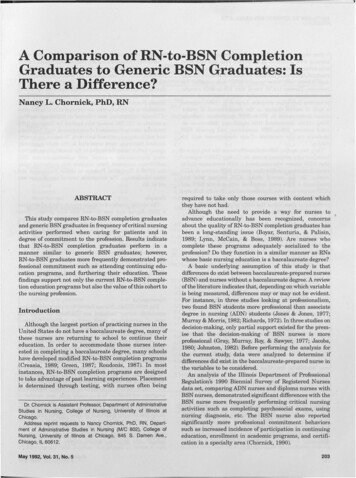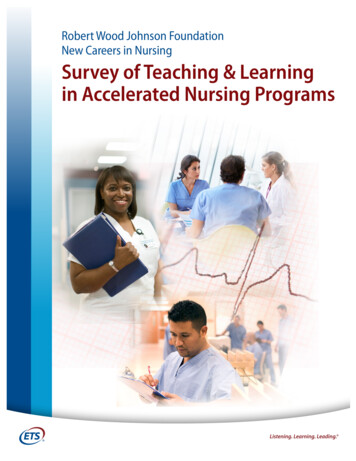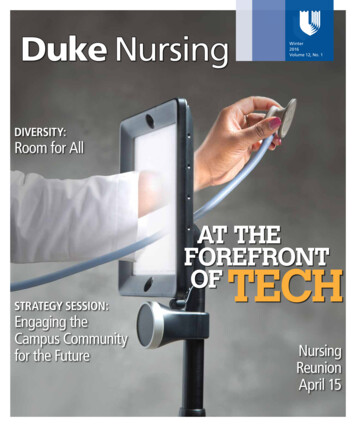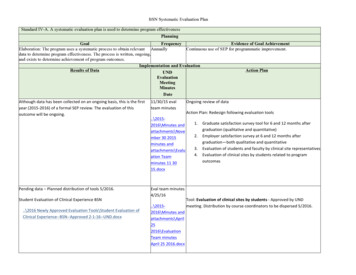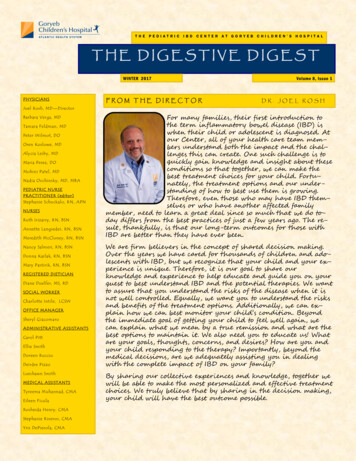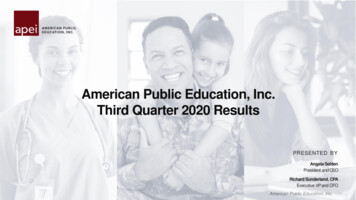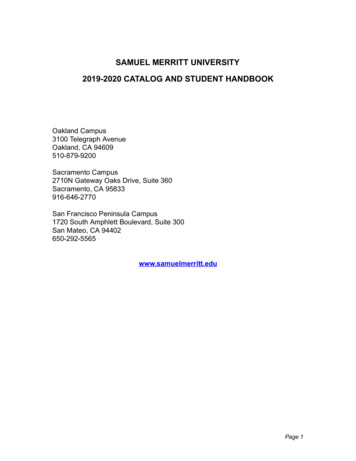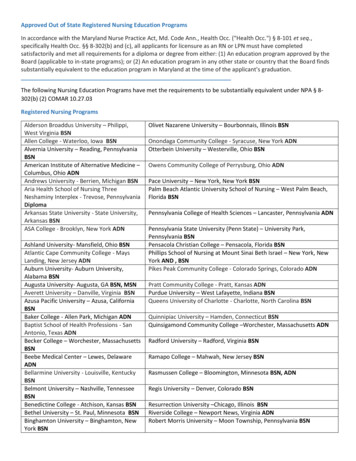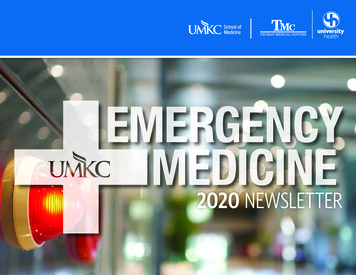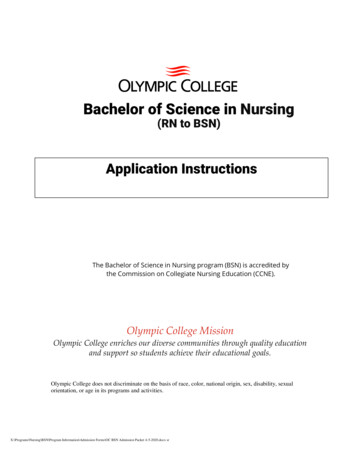
Transcription
Characteristics ofAccelerated BSN StudentsGeralyn A. Meyer, PhD, RNSaint Louis University School of Nursing
Saint Louis Universityaccepted 10 studentsinto the nation’s firstAccelerated BSNProgram in 19711972-19753 year grant from NIH
That was then. . .Requirements of the first ABSN programBaccalaureate or higher degree—most recentwithin the past 5 years3.0 GPA unless otherwise recommended byadmissions committeePrerequisites completed Chemistry (4 hrs), Anatomy & physiology (4 hrs),Microbiology ( 3 hrs), Social behavioral science (9hrs)
That was then. . .84 students in 1972-197514 men (17%)Mean age 26Previous degrees 32% Social Science 21% Physical science25% had previous healthcare experienceDescribed as “highly motivated, close knit andachievement oriented”
This is now. . .205 Accelerated BSN Programs in 200737 in planning stagesGrowth 1987—10 programs 1990—31 programs 2003—129 programs56 Accelerated Masters Programs in 200713 in planning stages
This is now. . .9938 students enrolled in ABSN programs7% of all entry level BSN enrollees5881 ABSN graduates in 200714% of all entry level BSN graduatesAccelerated Masters Programs4303 enrolled, 1032 graduated in 20077% of all masters enrollees, graduates
Who are Current ABSN Students?Describe demographic characteristics of oneprogram’s recent ABSN students.Compare & contrast with other programsExplore personal characteristics that seemto be common among ABSN students.Discuss recent ABSN graduates’ plans for acareer in nursing.
Sources of DataAACN Fact Sheets on AcceleratedProgramsAACN 2007-2008 Enrollment andGraduations in Baccalaureate andGraduate Programs in Nursing
Sources of DataSaint Louis University (SLU) Program DataEvaluation of Accelerated Option Program2004-2008“Help Us Get to Know You” sheets, 2006-2008 Where do you see yourself in 1 year? 5 years? Who are the most important people in your life? What 3 words best describe you?Thoughts after 18 years of teaching ABSNstudents
ABSN Program at SLU12 month (May to May program)Primarily designed for college graduatesStarted admitting a limited number of nondegree students beginning in May 1999. 300 applicants a yearLast year 147 admitted; 69 enrolled in5/08
Sources of DataCINAHL literature searchTerms used Accelerated students, accelerated programs,accelerated BSN, second degree programs, seconddegree students, accelerated baccalaureate students,accelerated baccalaureate programsLimited to research, nursing journals, years2000 , programs in USA
Sources of DataCangelosi 2007George Mason University, Leesburg, VAHamner & Bentley, 2007Auburn University, Auburn, ALHeege & Larson, 2008South Dakota State University, Aberdeen, SDMullen, 2007Regis University, Denver, CO
Sources of DataRaines, 2007Florida Atlantic University, Boca Raton, FLSeldomridge & DiBartolo, 2005, 2007Salisbury University, Salisbury, MDSuplee & Glasgow, 2008Drexel University, Philadelphia, PAUtley-Smith, Phillips & TurnerDuke University, Durham, NCWalker, Martin et al., 2007University of Mississippi, Jackson, MS
Who Are ABSN Students in the 21stCentury?AgeSLU Current Class Mean 27.34 (SD 7.72) Age range of second degree students 21-62SLU Class entering in 2003 Mean 28 (SD 7.45) Age range of second degree students 22-51Consistent with literature Mean age 30.6 at Salisbury, MD in classes entering2003-2006
Who Are ABSN Students in the 21stCentury?GenderSLU Current class 9% male (n 6) 2003-2007 entering classes average 16% maleAACN—all BSN programs 10.5% maleIn the Literature Auburn 33% male from 1994-2005 Others 16-22% male
Who Are ABSN Students in the 21stCentury?EthnicitySLU 2008-2009 class 84% White, non-Hispanic 13% African American 6 born and raised outside of USA Korea. Peru, Hungary, Nigeria, Jamaica, HaitiSLU 2003-2004 class 4% African American
Who Are ABSN Students in the 21stCentury?EthnicityAACN data 74% White, 12% African American, 6% LatinoOther reports in literature Auburn U—92% White Florida Atlantic U—36% non-Caucasian Salisbury—80% White, rise in Internationalstudents Drexel—66% white, 11% African American
Who Are ABSN Students in the 21stCentury?Previous Academic DegreesSLU 2008-2009 class—63 students 23 physical sciences (36.5%)10 social sciences (15.9%)8 health related fields (12.7%)5 have graduate degreesSLU 2003-2004 class Physical Sciences 30.2% Social Sciences 22.6%
Who Are ABSN Students in the 21stCentury?Previous Academic DegreesAuburn Human / social science 24%, Science 16%Salisbury Science 47%, liberal arts 33%Drexel Biology 16%, psychology 15%, business 10%
Who Are ABSN Students in the 21stCentury?Time since first degreeSLU 2008-2009 class Mean time since graduation 4.43 years 35% 1 year or less prior to enrollment 9 graduated in 2008 19% graduated 5 years agoSLU 200-2004 class Mean time since graduation (3.7 years) 38% graduated 1 year prior to enrollment
Who Are ABSN Students in the 21stCentury?Time since first degreeFlorida Atlantic U--7.4 yearsSalisbury U—7.5 years 25% returning after more than 10 yearsRegis U 30% 1-3 years from 1st degree 50% more than 5 years
ABSN Students Tend To. . .Have a variety of reasons for choosingnursing as a careerDescribe themselves as CompassionateCaringHelpfulKind
Reasons for Choosing Nursing 2004TotalN (%)SeconddegreeN (%)NonDegreeN (%)Opportunities/Flexibility in nursing18(30.5)17(37.8)1(7.1)Rewarding nature ofnursing as a career13(22)12(26.7)1(7.1)Dissatisfaction withprevious career field9(15.3)9(20)1(7.1)Always wanted to bea nurse8(13.6)8(17.8)Personal experiencewith healthcare/nursingOther6(10.2)6(13.3)3(5.1)3(6.7)
ABSN students tend to. . .Be very selective in deciding on a nursingprogramConsider school’s ReputationNCLEX pass rateProgram durationLocationCost
ABSN students tend to. . .Change their mind about attending schoolSLU--147 admitted in 2008, 100 confirmed, 69enrolledStudents frequently defer admission Can’t finish prerequisites Family circumstances Financial concernsAuburn reported 28 student admitted, 19 actuallyenrolled in 2005
ABSN students tend to. . .Have a history of academic successMost programs have minimum GPArequirements SLU current class, Mean GPA 3.38 SLU 2003-2004, Mean GPA 3.28Previous degrees may foster “black & white”learnersAre often very grade conscious
ABSN students tend to. . .Have very definite plans for their future innursingWhere do you see yourself in 1 year? Only 7 of 69 unsure of area they wanted to work in 28 of 69 express interest in ICU/ ER75% take jobs in area they originally plannedInterested in graduate education 62% of current SLU students plan on graduate school At graduation, 90% interested in graduate school
ABSN students tend to. . .Be highly motivatedDescribe themselves as passionate, focused,determined, dedicated, hardworkingSelf-directed, needing little external motivation
ABSN students tend to. . .Have high expectations for the programand the facultyIn the classroom Little tolerance for disorganization “Tell me what I need to know” Love stories from faculty about clinical experiences Appreciate faculty who love what they do Make clinical world real Case studies
ABSN students tend to. . .Have high expectations for the programand the facultyIn the clinical area Demand clinical competence in faculty Help them connect the dots Individualize learning
ABSN students tend to. . .Have little tolerance for “busy work”Time is most precious commodityPapers, assignments, projects, clinical thatwaste time create anger, frustration “There were a lot of unnecessary assignments thatjust stressed people out and didn’t really produceany knowledge.”Meaningful clinical time is desired Public health & psychiatric mental health clinicalsoften unappreciated.
ABSN students tend to. . .Desperately seek feelings of confidenceand competence in practice of nursing“We all want to learn to be really good nursesin a short period” Cangelosi, 2007Focused on skills and actual practice in clinicalarea Current SLU students--only 15 of 69 have previoushealth care experience
ABSN students tend to. . .Be Stressed!!!!Academically Large amount of material to be mastered in short timeframe “the insanity of the work—very intense, no relief” Perceived need to do well to go on to graduate school Competition among students ESL students often particularly stressed
ABSN students tend to. . .Be Stressed!!!!Financially Students encouraged not to work Approximately 40% of 2008 SLU grads worked 4 hours per week in spring semester 30-36 hours per week to support self/ family Loans primary source of funding Tuition support from health care institutions presentsopportunities/ challenges
ABSN students tend to. . .Be Stressed!!!!Personally Other commitments in their lives SLU 19% have children Regis 21% have children “Did school work seven days a week.”; “Not enoughtime to do things.” Balance is tenuous Some students seem to add stressors to their lives
ConclusionBack to the futureLike 1970s classes, current students Described as highly motivated, achievementoriented Come from physical and social science backgrounds Typically do not have previous HC backgroundsUnlike 1970s classes Trending older, time since last degree Personal, financial stress increasing 1972 tuition 2890/ year
ConclusionABSN students need balance ofIntellectual abilityTime management and organizational skillsPersonal supportEmotional fortitude
ConclusionABSN faculty need to beAble to differentiate need to know from nice toknow.Willing to kill sacred cows when necessary Keeping in mind that students don’t always knowwhat they need to learn to become nurses
ConclusionABSN programs are not for every student(or for every faculty member) but they servea real need for some.As one 2008 SLU graduate stated,“I had a great experience. Met wonderfulpeople. Learned a lot. Got a job. Can’t ask formuch more.”
205 Accelerated BSN Programs in 2007 37 in planning stages Growth 1987—10 programs 1990—31 programs 2003—129 programs 56 Accelerated Masters Programs in 2007 13 in planning stages. This is now. . . 9938 students enrolled in ABSN programs 7% of all entry level BSN enrollees
